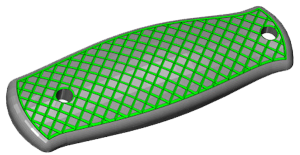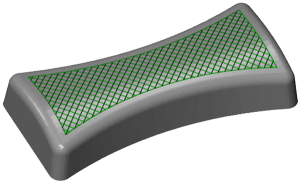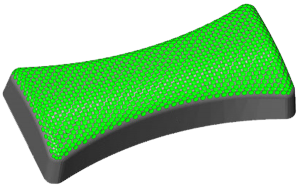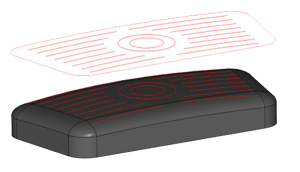When it comes to 3D Milling, your Toolpath Stepover affects your part’s finish. Depending on the kind of job you are working on, you may or may not want Toolpath scallops left on your part. Many manufacturers find the time it takes to remove these scallops isn’t justifiable and tool marks do change the look and the feel of the part. Let’s take a look at a sample part and the different finishes that are leftover based on the Stepover.
In this example, we will examine a knife handle. Using a 3D Toolpath like planar allows the tool will work its way back and forth over the model, similar to the way you mow your lawn. The Stepover amount is the distance between passes.

A 3D Planar Toolpath is one of the most common Toolpaths used in 3D Milling. Users can control the angle of the Toolpath as well as the Stepover amount. Based on the Stepover amount, more or less material will be leftover on the part. If you run 2 planar Toolpaths, each cutting in the opposite angle, you’ll get a crisscross pattern. This pattern leaves behind texture on the part. Have you ever considered applying texture to your parts? Many knifemakers and automotive accessory manufacturers find that using textures as part of their design helps make their parts stand out.

Subscribe to BobCAD-CAM's CNC Software Blog
Join your fellow manufacturers! Get BobCAD-CAM’s latest CAD-CAM articles straight to your inbox. Enter your email below:
Manufacturers are always seeking out new ways to make their parts look better than the competition. A simple crisscross pattern can do just that. For this reason, many clients begin to look for additional Toolpaths they can use to create similar results with different patterns. This is where projection-style Toolpaths come into play.

Projection-style Toolpaths allow the user to drive their Toolpath based on the wireframe geometry or sketches they develop, projecting them down onto the surfaces or solids they’re working with. Projection-style patterns provide limitless creative control, allowing the user to create patterns that aren’t typical.

Below are some sample parts our clients have used to create interesting results. To learn more about creating patterns on your parts, click HERE for a free trial of BobCAD’s latest CAD-CAM software. Want to learn how to use the software? Click HERE to sign up for our free webinar training that includes sample files.

BobCAD-CAM has provided CNC Software products to the global manufacturing industry for over 30 years. BobCAD-CAM software can be found to increase CNC productivity for many applications including educational and independent hobby home use. Products include machining technology for 2, 3, 4 & 5 Axis CNC Milling, Routing, Waterjet, Plasma and Laser machines as well as 2 Axis CNC Lathe. BobCAD-CAM also provides a variety of quality training products that include regional and online training classes or private sessions tailored to specific applications. Professional certification can be acquired as well as multi-tiered technical support solutions to their service customers.
Contact BobCAD-CAM today at 877-262-2231 or 727-442-3554.
You’re one click away from subscribing to BobCAD’s YouTube channel. Click the link below for tips, how-tos and much more!
Summary
Article Name
How To Apply Textured Finishes With BobCAD’s 3D Milling CNC Software
Description
When it comes to 3D Milling, your Toolpath Stepover affects your part’s finish. Depending on the kind of job you are working on, you may or may not want Toolpath scallops left on your part. Many manufacturers find the time it takes to remove these scallops isn’t justifiable and tool marks do change the look and the feel of the part.
Author
Michael A. Downss
BobCAD-CAM Software